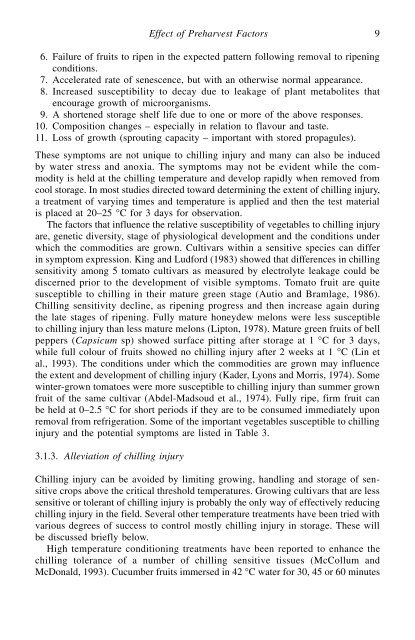Production Practices and Quality Assessment of Food Crops. Vol. 1
Production Practices and Quality Assessment of Food Crops. Vol. 1
Production Practices and Quality Assessment of Food Crops. Vol. 1
Create successful ePaper yourself
Turn your PDF publications into a flip-book with our unique Google optimized e-Paper software.
06. Failure <strong>of</strong> fruits to ripen in the expected pattern following removal to ripening<br />
conditions.<br />
07. Accelerated rate <strong>of</strong> senescence, but with an otherwise normal appearance.<br />
08. Increased susceptibility to decay due to leakage <strong>of</strong> plant metabolites that<br />
encourage growth <strong>of</strong> microorganisms.<br />
09. A shortened storage shelf life due to one or more <strong>of</strong> the above responses.<br />
10. Composition changes – especially in relation to flavour <strong>and</strong> taste.<br />
11. Loss <strong>of</strong> growth (sprouting capacity – important with stored propagules).<br />
These symptoms are not unique to chilling injury <strong>and</strong> many can also be induced<br />
by water stress <strong>and</strong> anoxia. The symptoms may not be evident while the commodity<br />
is held at the chilling temperature <strong>and</strong> develop rapidly when removed from<br />
cool storage. In most studies directed toward determining the extent <strong>of</strong> chilling injury,<br />
a treatment <strong>of</strong> varying times <strong>and</strong> temperature is applied <strong>and</strong> then the test material<br />
is placed at 20–25 °C for 3 days for observation.<br />
The factors that influence the relative susceptibility <strong>of</strong> vegetables to chilling injury<br />
are, genetic diversity, stage <strong>of</strong> physiological development <strong>and</strong> the conditions under<br />
which the commodities are grown. Cultivars within a sensitive species can differ<br />
in symptom expression. King <strong>and</strong> Ludford (1983) showed that differences in chilling<br />
sensitivity among 5 tomato cultivars as measured by electrolyte leakage could be<br />
discerned prior to the development <strong>of</strong> visible symptoms. Tomato fruit are quite<br />
susceptible to chilling in their mature green stage (Autio <strong>and</strong> Bramlage, 1986).<br />
Chilling sensitivity decline, as ripening progress <strong>and</strong> then increase again during<br />
the late stages <strong>of</strong> ripening. Fully mature honeydew melons were less susceptible<br />
to chilling injury than less mature melons (Lipton, 1978). Mature green fruits <strong>of</strong> bell<br />
peppers (Capsicum sp) showed surface pitting after storage at 1 °C for 3 days,<br />
while full colour <strong>of</strong> fruits showed no chilling injury after 2 weeks at 1 °C (Lin et<br />
al., 1993). The conditions under which the commodities are grown may influence<br />
the extent <strong>and</strong> development <strong>of</strong> chilling injury (Kader, Lyons <strong>and</strong> Morris, 1974). Some<br />
winter-grown tomatoes were more susceptible to chilling injury than summer grown<br />
fruit <strong>of</strong> the same cultivar (Abdel-Madsoud et al., 1974). Fully ripe, firm fruit can<br />
be held at 0–2.5 °C for short periods if they are to be consumed immediately upon<br />
removal from refrigeration. Some <strong>of</strong> the important vegetables susceptible to chilling<br />
injury <strong>and</strong> the potential symptoms are listed in Table 3.<br />
3.1.3. Alleviation <strong>of</strong> chilling injury<br />
Effect <strong>of</strong> Preharvest Factors 9<br />
Chilling injury can be avoided by limiting growing, h<strong>and</strong>ling <strong>and</strong> storage <strong>of</strong> sensitive<br />
crops above the critical threshold temperatures. Growing cultivars that are less<br />
sensitive or tolerant <strong>of</strong> chilling injury is probably the only way <strong>of</strong> effectively reducing<br />
chilling injury in the field. Several other temperature treatments have been tried with<br />
various degrees <strong>of</strong> success to control mostly chilling injury in storage. These will<br />
be discussed briefly below.<br />
High temperature conditioning treatments have been reported to enhance the<br />
chilling tolerance <strong>of</strong> a number <strong>of</strong> chilling sensitive tissues (McCollum <strong>and</strong><br />
McDonald, 1993). Cucumber fruits immersed in 42 °C water for 30, 45 or 60 minutes

















